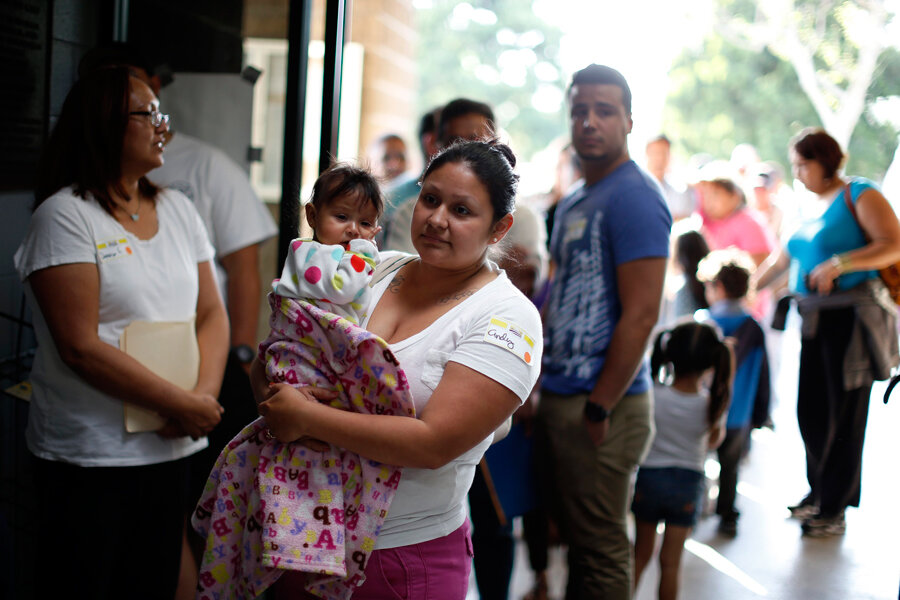Obamacare enrollment at 7.5 million. But how are exchanges really doing?
Loading...
| Washington
Of all the people who have enrolled in the Obamacare marketplaces for health coverage, 1 in 20 have done so after the official deadline of March 31 – and that number is still rising.
So, from the perspective of helping Americans enroll, the Obama administration’s move to make that deadline flexible paid off in a big way. Health Secretary Kathleen Sebelius said Thursday that 400,000 Americans have enrolled in the marketplaces since March 31, bringing the total enrolled to date to about 7.5 million.
“And we expect that number to continue to grow,” she said at a Senate hearing.
Early forecasts by the Congressional Budget Office were that the Affordable Care Act (ACA) would sign up 7 million on the exchanges in this first year of enrollment, and that the total number of uninsured Americans would fall by 13 million people. Troubles with the HealthCare.gov website cast doubt on whether the administration would hit that target.
Although the new 7.5 million figure has sparked a flurry of interest, some big questions remain.
One is, how is the law doing at its broader goal of reducing the ranks of the uninsured? Another is, will the enrollees on the 50 state-level marketplaces be about as healthy as expected? If they are less healthy than expected, they might draw on medical services so much that insurers raise premiums.
It will probably take a while to get firm answers to those questions. But this week, results of two new polls suggested that share of Americans who aren’t covered by health insurance has been falling substantially during the six-month period ending in March that was set for Obamacare enrollment.
Many of the newly insured Americans are adding coverage through employer-sponsored plans, according to the survey by RAND Corp. This is partly due to the nation’s falling unemployment rate and perhaps partly due to a boost in employee participation from Obamacare’s “individual mandate” to be insured.
Medicaid, which was expanded by the ACA, also accounted for a big share of the gains. Shopping on the ACA marketplaces was a less-significant factor, according to the poll.
Marketplace directors from five states offered further insights into the ACA rollout in a conference call for reporters Thursday.
These were states that run their own exchanges for people to shop for health insurance. About one-third of the states had their own exchanges, while the remaining two-thirds relied on the federal HealthCare.gov website for enrollment.
Several of them confirmed the point made by Secretary Sebelius – that enrollment numbers during recent days have been significant. Many states have also granted a grace period designed for people who had started to sign up by March 31 but hadn’t finished.
In Kentucky, one-third of enrollees on the state exchange have been between the ages of 25 and 34, said Bill Nold, deputy executive director of the exchange.
Nationally, some health care experts have suggested that the exchanges should be drawing about 40 percent of their enrollment from that age group – which is relatively less likely to have insurance and which costs less to insure compared with older age groups. The signup rate in Kentucky may be less than some hoped, by that measure, but it’s not terrible.
An oft-mentioned worry is that, if only the “old and sick” sign up, the cost of providing insurance will be high and premiums will soar.
One bit of evidence reported this week suggests that might be happening to some degree.
Data from January and February suggest that about 1.1 percent of total prescriptions in plans bought on the Obamacare exchanges are for specialty medications, which tend to be very costly, according to the pharmacy-benefit provider Express Scripts. That's higher than the 0.75 percent of total prescriptions in commercial health plans.
Express Scripts also said the exchange enrollees were 35 percent more likely to use pain medication, 14 percent more likely to use antidepressants, and 31 percent less likely to use birth-control drugs.
Asked about this report during the Thursday conference call, Peter Lee of Covered California, California’s exchange, said he hasn’t seen signs that exchange enrollees are making higher-than-normal insurance claims. He called the study a fairly narrow window into the question of exchange demographics.
Kevin Counihan, CEO of the Connecticut exchange, said it’s still too early to have reliable information about costs, given that so many of the Obamacare enrollments happened in February and beyond.
With or without good information, insurance firms across the country don’t have long before they’ll need to start submitting prices for coverage during next fall’s exchange enrollment period.
One positive sign for potentially lower prices is that more insurance companies may offer marketplace coverage next year in some states. Consumers stand to benefit when more companies compete for their business.
New insurers have expressed interest in Washington State, Kentucky, and California, the exchange directors from those states said.
The states on the conference call, which was organized by the group Families USA, were ones that were more successful than average at drawing eligible enrollees onto their exchanges.








